| Article ID | Journal | Published Year | Pages | File Type |
|---|---|---|---|---|
| 6453773 | Applied Catalysis B: Environmental | 2017 | 9 Pages |
â¢A layered BiO(OH)xI1-x solid solution was grown on the surface of AgI particles.â¢9-fold enhanced photoactivity was achieved for the BiO(OH)xI1-x-AgI heterojunction.â¢AgI photodecomposition was suppressed without any release of Ag+.â¢The interfacial Ag-I-Bi chemical bond junction accelerated carriers transfer.â¢The spatial separation of photoexcited electrons and holes was realized.
A layered BiO(OH)xI1-x solid solution was grown in situ on the surface of AgI particles by a one-pot co-crystallization method. Based on the results of XPS, EPR, XRD and other techniques, it was verified that a p-n heterojunction was formed through Ag-I-Bi cross-linking bonds in the interface of BiO(OH)xI1-x and AgI due to the common species of Iâ ions. The resulting BiO(OH)xI1-x-AgI exhibited high efficiency and stability for photodegradation of phenolic compounds with visible light irradiation. No significant AgI decomposition or release of Ag+ or Bi3+ was observed in the photoreaction, and the photoactivity of AgI was enhanced almost 9-fold. These enhanced photocatalytic properties were attributed to the strong interfacial interaction between BiO(OH)xI1-x and AgI by the Ag-I-Bi bond junction. Due to the chemical-bond junction, the photogenerated electrons in the CB of AgI quickly transferred to the CB of BiO(OH)xI1-x to produce O2ï¼, while the holes in the VB of BiO(OH)xI1-x migrated to the VB of AgI to oxidize pollutants in water. The accelerated interfacial charge transfers were responsible for the high photostability and photoactivity of BiO(OH)xI1-x-AgI.
Graphical abstractDownload high-res image (138KB)Download full-size image
